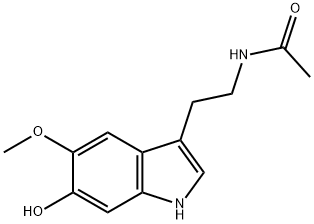Description
6-hydroxy Melatonin is an active metabolite of melatonin . It is formed from melatonin by the cytochrome P450 (CYP) isoform CYP1A2 in human liver microsomes. 6-hydroxy Melatonin is a melatonin 1A (MT
1A), MT
1B, and MT
2 receptor agonist. It inhibits dopamine release from isolated rabbit retina (IC
50 = 0.0016 μM). 6-hydroxy Melatonin (10 and 100 μM) reduces increases in the levels of NF-κB, IL-6, and IL-8 and decreases in glutathione (GSH) levels in LPS- and peptidoglycan G-stimulated human umbilical vein endothelial cells (HUVECs) in an
in vitro model of sepsis. It reduces iron-induced lipid oxidation in rat hippocampal homogenate when administered at a dose of 10 mg/kg.
Chemical Properties
Off-White to Pale Beige Solid
Uses
A metabolite of Melatonin (M215000).
Uses
A metabolite of Melatonin (S689050).
Uses
A major human metabolite of Melatonin
Uses
6-Hydroxymelatonin has been used as a melatonin derivative to test its protective effects in ultra violet B (UVB)-induced oxidative stress melanocytes and keratinocytes.
Definition
ChEBI: A member of the class of tryptamines that is melatonin with a hydroxy group substituent at position 6.
General Description
6-Hydroxymelatonin (6-OHM) is a melatonin metabolite. It is produced in the liver by the action of cytochrome P450 enzyme as well as by photodegradation of melatonin. In the central nervous system, it exists as a sulfated form. 6-OHM is a partial melatonin receptor MT2 agonist.
Biochem/physiol Actions
6-Hydroxymelatonin (6-OHM) is an antioxidant with a free radical scavenging role. Like melatonin, it reduces the impact of UVB-induced oxidative stress in melanocytes. It also aids protection during iron (Fe2+)-induced neurotoxicity. 6-OHM effectively reduces lipid peroxidation and superoxide anion production induced by potassium cyanide (KCN).


